All Rhodes
I’m bombing down a forest trail. Wheels judder. Pebbles shoot in all directions. Panniers rustle behind my seat post. Palms ache against the vibrations of my handlebars. Vision blurs as the bike plummets faster, faster through the trees.
The path levels out. My tires bounce over roots and rocks. My front wheel oscillates, embracing the curvature of packed earth. My pedals rotate, slow and silky. It feels so good — rolling over the loamy ground, breeze on my sweaty face, trees whisking past. I gulp down fresh air, which tastes of pine needles.
At last I grab the brakes. My brand new Trek Marlin 5 squeaks to a stop. My boots touch the ground for the first time in miles. Evergreens tower all around; their branches plume over a bright blue sky. All the commotion dies away, replaced by stillness. Somewhere, a woodpecker taps a tree. Midges hover around my head. But overall, the scene is quiet and motionless. No engines, anywhere. No white streaks of passing jets. No bleeps or buzzes. Not a single human voice. I might as well be standing in the middle of a wilderness, a thousand miles from civilization.
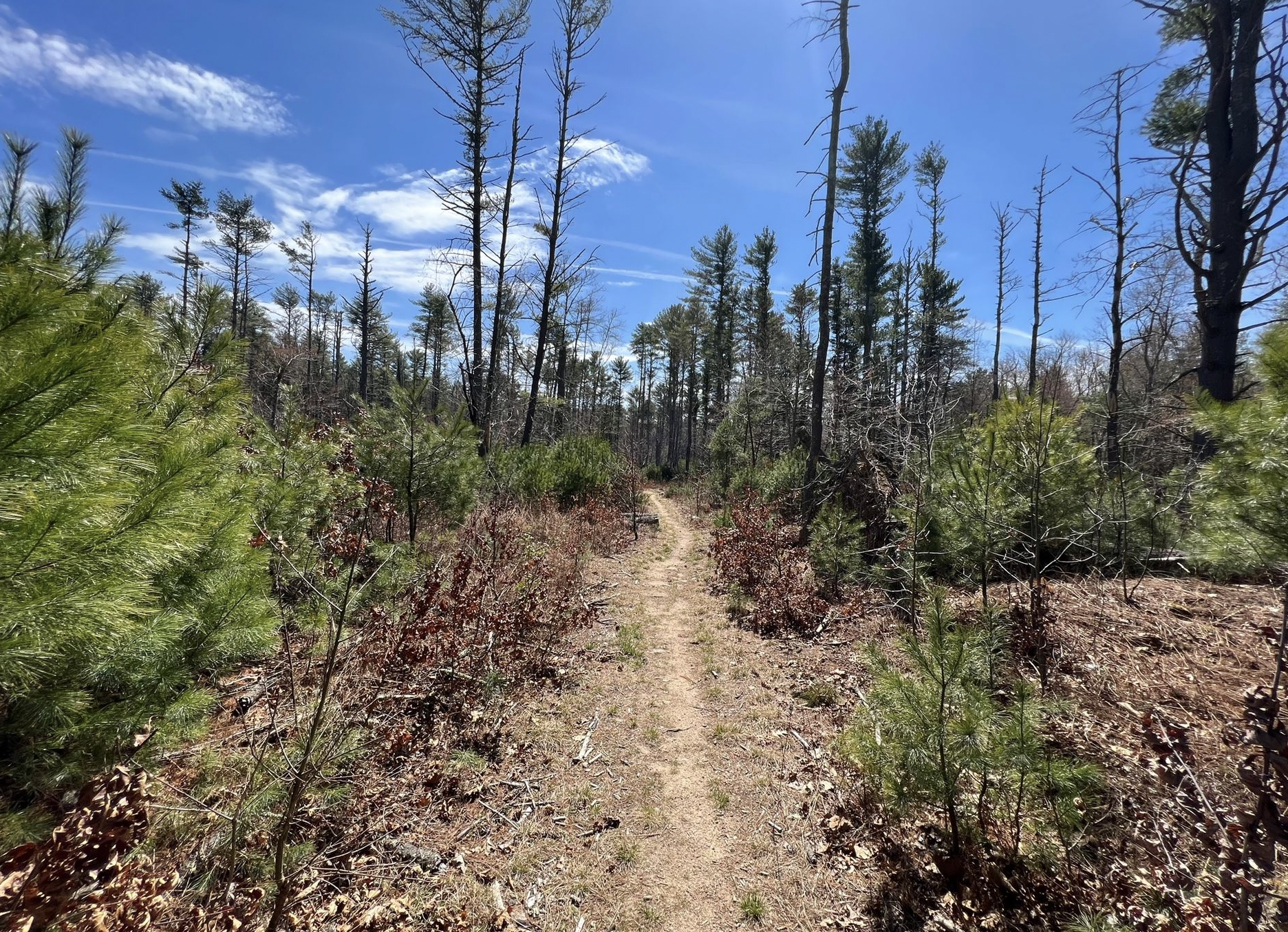
But it’s not a wilderness: it’s the Carolina Management Area. And civilization is close by. This is Rhode Island, after all, and nothing can be very far away. My own doorstep lies only 30 miles from where I’m catching my breath. Once I reach a road, I could probably hail an Uber back to Providence. This kind of solitude feels like a mathematical impossibility in Rhode Island, which has both the country’s smallest land area and highest population density. How can we fit a million people into such a small space — plus bays, harbors, coves, and rivers — and yet still have thousands of acres of forest? Today I’ll bike all afternoon, and I’ll pass more colonial graveyards than living people.
What makes this possible? The North-South Trail, a 78-mile network of back roads and paths amid Rhode Island’s tightly packed population that improbably meander across the whole state and has kindled a newfound love of bikepacking that has easily doubled the size of my world.
***
A quick getaway — that’s what I needed. Near, but far. A place I’d never been to, but one easy to return from. I had two weekdays free, and they had to count. So at 9:00AM I affixed loaded panniers to their racks and pushed my new bike out of the garage.
The Providence train station is a five-mile ride from my house. The train arrived only slightly late. On the platform, an Amtrak conductor helped me board and hang up my Trek.
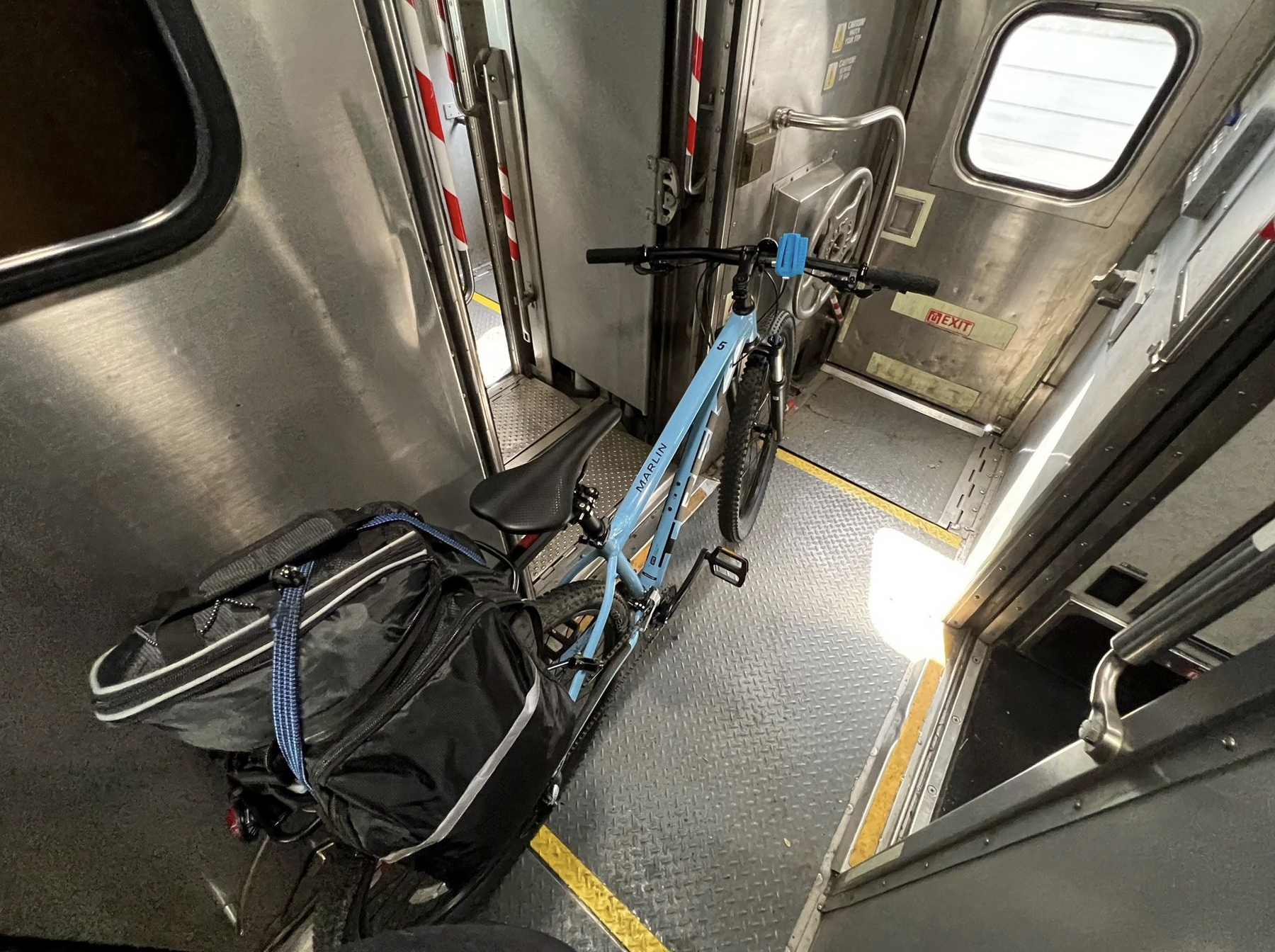
“This is all new,” she said, gesturing to a special alcove at one end of the car. “Somebody was supposed to show us how to use it, but they haven’t set up the training yet. So we’re just doing the best we can.”
“No problem,” I said, lifting my Trek’s rear wheel onto the designated hook. “I’m just glad you can take a bike at all.”
I avoid driving whenever I can, and I hate the idea of asking my wife to drive two hours round-trip just to drop me off at a trailhead. The train chugged through the Providence suburbs. Familiar shopping plazas and water towers flashed past the windows, followed by ponds and woodland. A half-hour later, I bumbled off the train with my bike, smack-dab in the middle of Westerly. No car, no interstate, no parking meter.
I rode a single lap around Westerly, a picture-perfect village that straddles the Pawcatuck River. As I pedaled away from Main Street, the antique facades melted into residential roads, then rural byways. The hills gently rose and fell. Around noon, I spotted the tree-shaded banks of Meadowbrook Pond, where fishermen had parked their pickups. I coasted across the gravel lot and onto a dirt trail.
Then I saw it: on the bark of a tree, a rectangle of blue paint. This was a blaze — the first of hundreds that would guide me along the North-South Trail.
The North-South Trail isn’t widely known, but the route is a rite of passage for serious Ocean State hikers. The trail starts at Sam Ferrenti Town Beach, on the shores of the Atlantic. It zigzags northward, crossing the Connecticut border several times, before terminating in Douglas State Forest, just over the state line. Private campgrounds are scattered along the way, where backpackers can bed down for the night. The North-South trail connects with the Midstate Trail, which bisects Massachusetts, which in turn becomes the Wapack Trail in New Hampshire. Friends of mine have hiked segments of the North-South Trail, but I’ve never met anyone who completed it. And this makes sense; walking the trail’s entire 78 miles can take up to a week, and most hikers I know would rather spend that time somewhere more exotic than western Rhode Island.
Then I wondered: Could someone ride the North-South Trail? If a standard mountain bike could handle the terrain, I could probably finish the route in just two days. The idea excited me. After years of cycling the same roads and bike paths across the state, I could finally break new ground. And in the unlikely event that something went wrong, I could circle home in an hour or so.
But were bikes permitted? Google gave no indication. Many New England trail systems are off-limits to bicycles of any kind, and it’s sometimes hard to know in advance. I called the Department of Environmental Management to find out. A nervous young voice answered the phone.
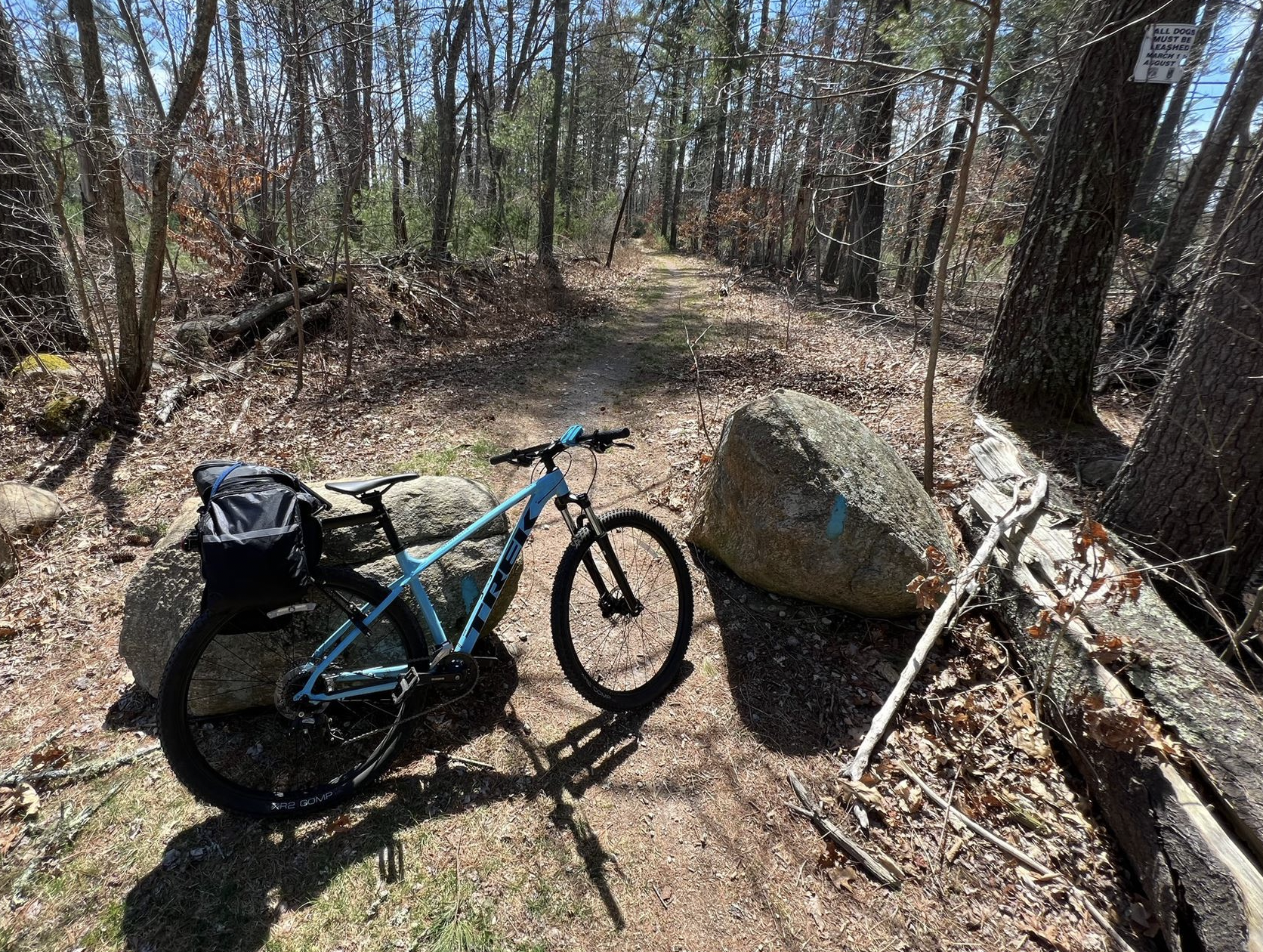
“Bike the … what again?”
“The North-South Trail. I just want to make sure it’s allowed. I know there are sometimes concerns about erosion and whatnot.”
“The North-South Trail,” he said uncertainly. “Can I put you on hold?”
Minutes passed. At last the voice crackled back to life. “Sorry about the wait, sir. Yes, you can. You just can’t take anything with a motor.”
“Oh, right. I wouldn’t.”
“Okay. Good. Anything else I can help you with?”
I thanked him. That flimsy oral contract was good enough for me. I’d never heard of anyone biking the North-South Trail before; there was no telling whether the route was passable on two wheels. I’d just have to go and see.
*
The high today is 75 degrees, and there’s nary a cloud in the sky. The coastal headwind has calmed. Such perfect weather should be unthinkable in mid-April, but here it is, showering me with golden light. I’ve packed layers, but I can’t imagine needing them. Even long pants would feel overdressed.
The Trek handles like a dream. I’ve never owned a true mountain bike before, and I still can’t believe what a tank it is. The two-inch tires crunch over nettles and leaves, rocks and loose gravel. The rubber knobs latch onto tree roots and vault me over boulders. In the lowest gears, the Marlin 5 seems to defy gravity, dancing over debris that would have wrecked the rims of my hybrid. I still hesitate on the descents, but hydraulic disc brakes ease us down, chirping as I drop over another ledge. The landscape is forgiving to a rookie. I have no need for berms or jumps. All I want is this magic power — to go beyond the pavement, to keep moving even when the road ends.
Where has this been all my life? I think.
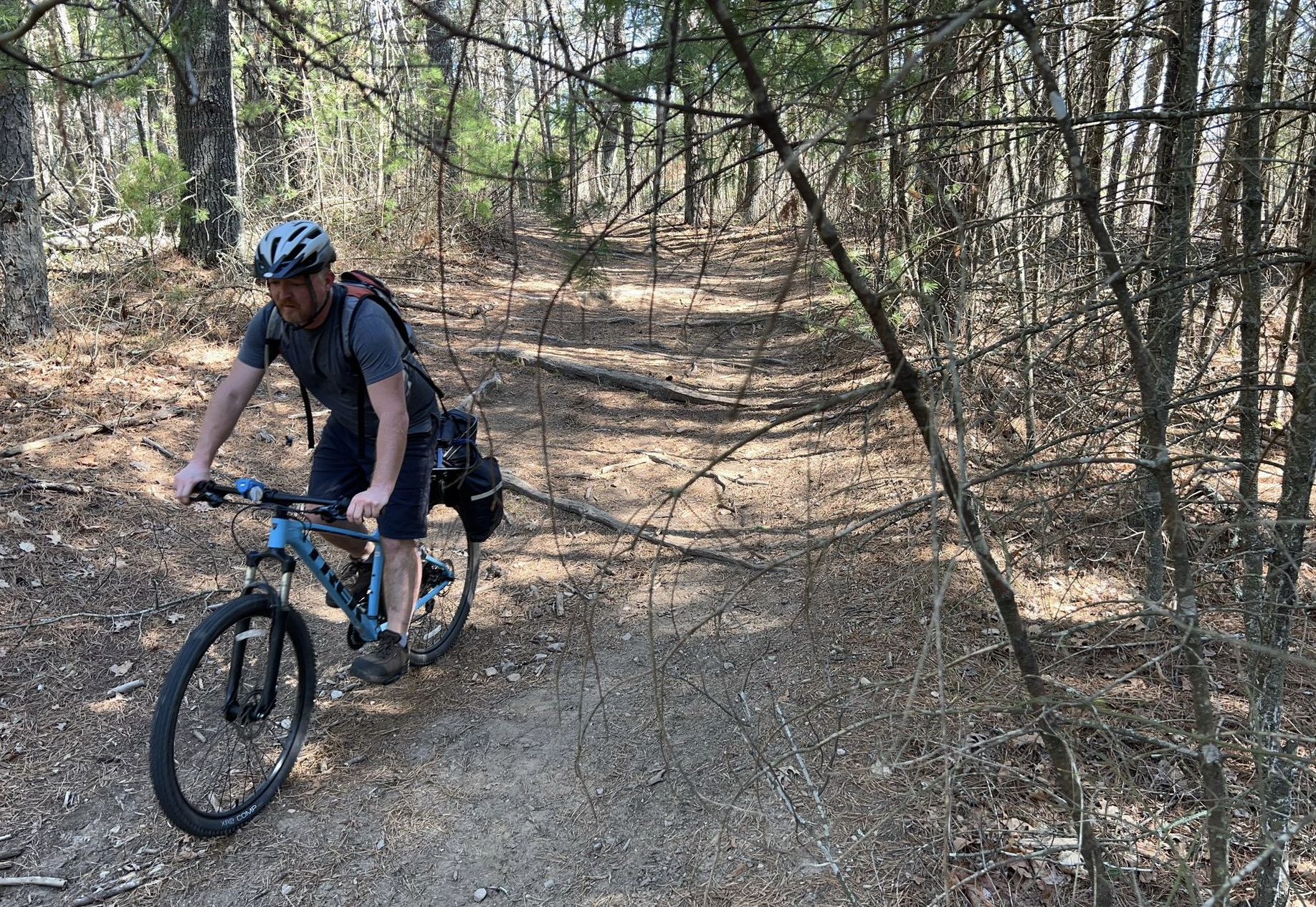
Mountain biking has always been there, of course. My high school buddies tore up the Green Mountains every weekend. Pittsburgh has some of the best urban mountain biking in the country. Phoenix boasts more gravel and singletrack than I could ride in a lifetime. I’ve lived in all of these places, for years, riding a road bike almost every day. Yet somehow, the concept didn’t click until age 43, after I’d left all of them behind. You don’t have to stop at the end of the road. You can hop that curb. You can cross that lawn. That narrow track, disappearing into the glade? You can follow it and see where it leads. The journey might be longer than you think.
Much of the North-South Trail follows two-lane motorways; travelers trudge for miles down the road’s shoulder as cars and trucks roar past them. Over the course of the day, I pass only one thru-hiker, a burly young man with a backpack and bandana. We shout pleasantries over the wail of traffic. I can’t help but sympathize with folks like him, inhaling fumes for hours on end. I don’t mind riding down highways, because the tarmac is smooth and fast, and in a matter of minutes, I’ll slip through another trailhead. The landscape won’t just exist to my right and left; I’ll be in the landscape, as close as a traveler can get without faceplanting. Hikers will experience the same thing, eventually, but at one-quarter the speed.
Then I hit a snag — literally. The trail beyond Buttonwoods Road is steep and rocky. The forest closes in; thorns slash my ankles. A fallen tree lies over the path, too large to bunny-hop. I heave my bike over, ride another 50 feet, then stop for another. Log after log blocks my way, a nuisance for hikers, but a serious impediment for bikes. The blue blazes no longer match my GPS, and I ride in figure-eights through the forest until the path spits me onto an interstate exit ramp.
You don’t have to stop at the end of the road. You can hop that curb. You can cross that lawn. That narrow track, disappearing into the glade? You can follow it and see where it leads. The journey might be longer than you think.
What follows is a jarring experience: thrilling dashes through the forest followed by unrideable piles of stone. First I float down a mile of paved backroad; then I’m shoving my bike over rivers of dry sand. Now I’m embracing the sylvan tranquility of the deep country; then I pass a row of “NO TRESPASSING” signs and barely hidden surveillance cameras. Some folks wave from their lawn chairs, or just nod stoically. But when I drain the last water from my Camelbak, I know there isn’t a store — or a water fountain, or anything — for miles. None of the campgrounds are open yet for the season. There’s nothing to do but keep going.
When I finally reach my motel, on the outskirts of Moosup, Connecticut, I collapse onto the mattress and groan at the ceiling. My body is spent, not to mention cut, sunburned, dehydrated, saddle-sore, and covered in insect bites. Even my contact lenses are fuzzy with dust. This has been one of the hardest riding days of my life; what little off-roading I’ve ever done was nothing compared to these 43 miles, and I can’t believe it all happened in a single day.
But like all good rides, I’ll remember so much more than my aching bones.
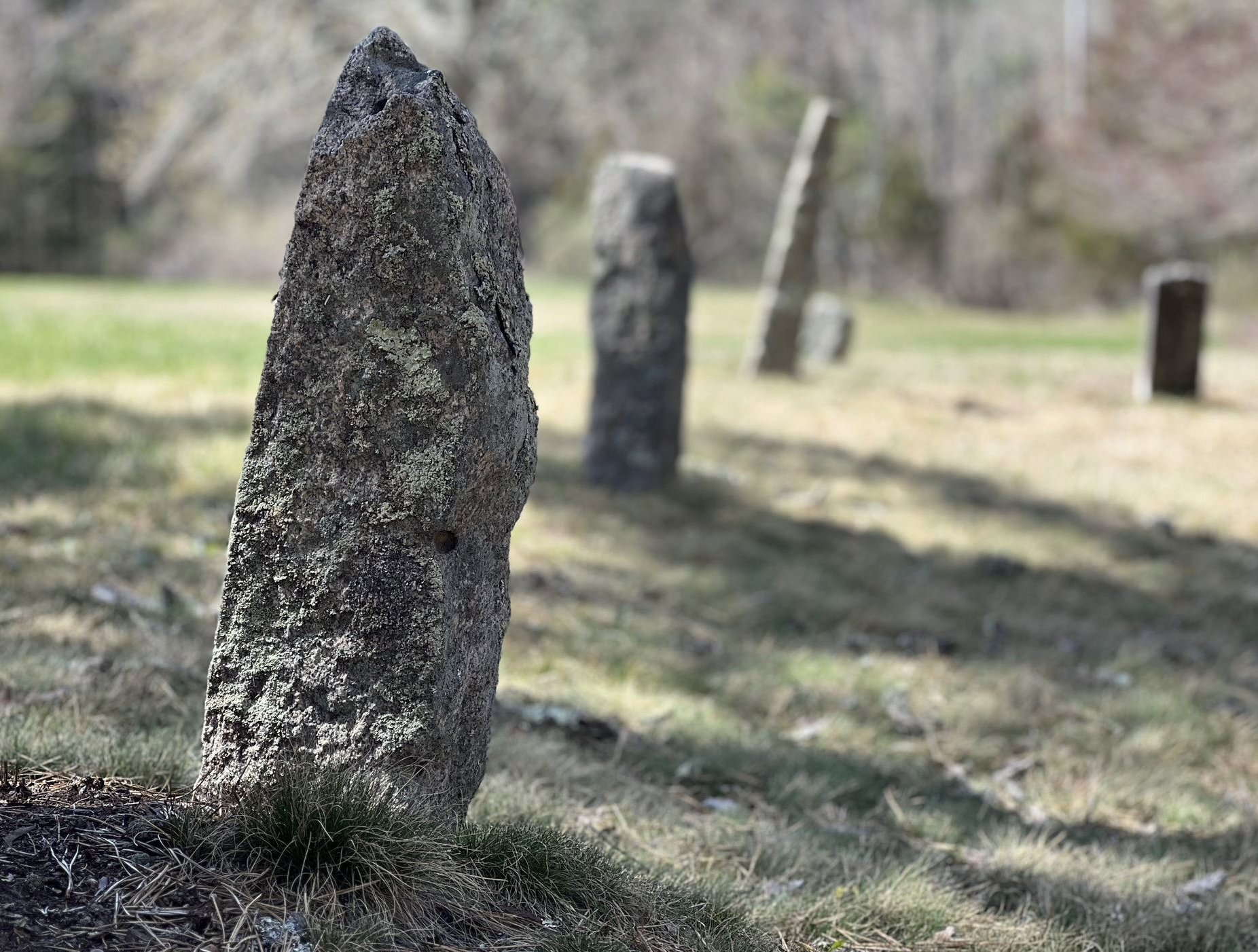
I’ll recall this trip in flares and flickers: The wild turkey that raced me down the road. The dead snake I steamrolled. A horse-drawn wagon marked “for sale.” The arc of a stone bridge above a glassy river. The subtle track beaten across a meadow. As much as I have loved road cycling, for thousands of miles on three continents, off-roading has reinvigorated my senses. It’s such a close-up experience, like holding the page of a book right up to my eyes.
That night, I hang out in the roadhouse across the parking lot. It’s dark and gritty, and guys in flannel shoot pool for money. The bartender has a sour expression, but she promptly sets down my tacos and teriyaki wings and mug of IPA.
“Hungry, huh?” grunts a swaying old man.
“Sure am,” I say through a mouthful of chicken.
The man proceeds to ramble about his life, how he’s worked at the motel for 30 years, how it used to be a total stye, but the new owner cleaned it up. The man is slurring, and I wince as he orders another shot.
Later, I strike up conversation with one of the pool players. He tells me about a big tournament in Pennsylvania, about his souped-up camper van, about his separation from his wife, about retiring early from a career as a corporate manager.
I can’t say I love Moosup, and I wonder if I’ll ever return. I doubt any of these guys, guffawing over their cues, vote the way I do, watch the same television, or would spend their vacation time the same way. But I like being here. I like that I would never have thought to come here, except that this is where the trail led. I like knocking back a pint in a random bar, placing myself in the middle of the action for an hour or two. My visit is unremarkable, and I’ll never forget it.
*
When I wake up, I’ve already decided that I won’t finish the North-South Trail. Not today, anyway.
I’m miffed, of course. The distance is doable, and most of the remaining route appears to be roads. The weather remains sunny and warm, a rare luxury in early spring. Come Monday, I’d love to barge back into the office, tanned and beaming, as I brag about my achievement to coworkers. I just rode the North-South Trail! Across the whole state! How was your holiday?
Just one problem: The North-South Trail ends in the middle of nowhere. In theory, at the end of this 40-mile segment, I could bike another 10 miles and arrive in the town of Burrillville, where there’s supposedly a RIPTA stop, and an afternoon bus might carry me back to Providence. But I hesitate to travel so far to catch a bus I’ve never ridden. Is the stop well marked? Will it have a rack? Will the rack already be carrying its maximum load of two bikes? What if the bus runs late? And won’t it just deposit me in Downcity, another seven miles from my house? Do I really want to crank out 17 extra miles for the sake of a 75-minute bus ride?
Instead, I can just beeline home. As it happens, the town of Moosup is the gateway to the Moosup Valley State Park Trail, a 10-mile route that connects to the Washington Secondary Bike Path, which continues 19 miles to (basically) my house. The Moosup Valley route is technically a rail-trail, but it’s unpaved, which is exactly what I’ve been seeking on this trip. I’ve taken the Washington Secondary dozens of times, but I’ve always stopped at the end, knowing my hybrid couldn’t handle the obstacle course of deep puddles and loose gravel. Today, on a mountain bike, everything seems possible.
The Moosup trail starts at a scenic trestle bridge, leading riders out of town. The smooth blacktop goes on for a mile or so, then dissolves into a stagnant river. Fallen leaves and brown water have mixed into a foul-smelling sludge, which covers the former railroad bed and extends as far as the eye can see. The way would seem impassable, but on one side of the trail, visitors have carved a rough path, which snakes its way through the trees. Again, the Marlin 5 dominates the landscape, rolling over rocks and rises, the wide handlebars narrowly missing a row of saplings. I ride parallel to the rail-trail until a drier section emerges and I plunge down the hill. My tires devour the dirt for mile after mile.
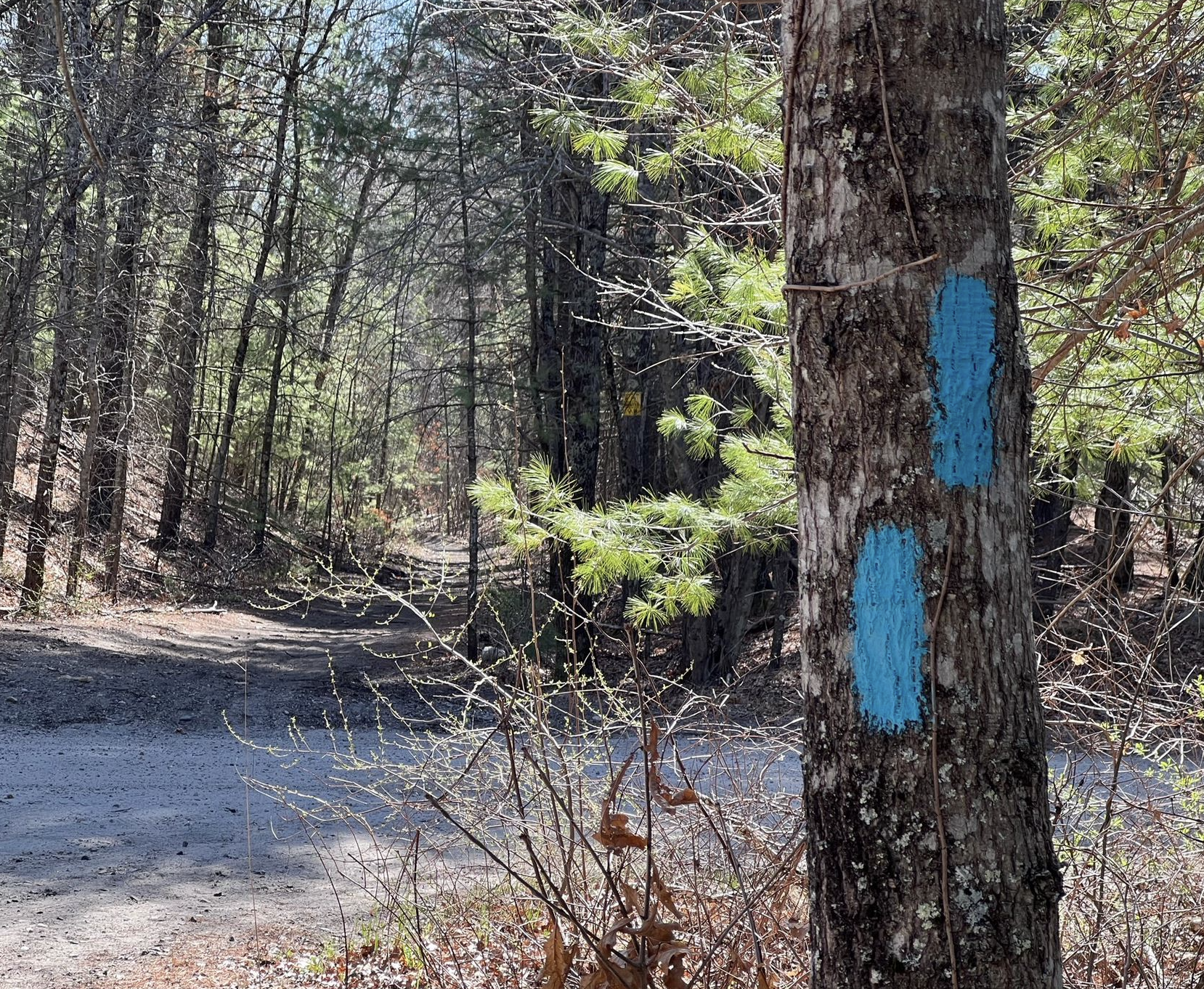
When I reach the Washington Secondary, the pavement feels glassy beneath my wheel. I buzz along, barely pedaling, wind in my ears. My knobby tires still manage to glide over asphalt. I know this final stretch well, and I could easily zone out, hypnotized by level ground and familiar landmarks. But this time is different: Now I notice the ruts that branch off into the woods. I see where grass has been tamped down, forming tracks across meadows. I could follow them, now, wherever they stray. A little extra rubber opens up every direction at once. The landscape is new again, revitalized with so much possibility.
Suddenly, I’m back to my neighborhood, then street, then backyard. I guide my mud-spattered bike into the garage and hang it up. I sneak into the house, where my wife is in the middle of an online meeting, and the dog barks only once. Showered and changed, I jump in the car, headed to the grocery store, then my son’s school. Regular errands for a regular day. Like I never left.
But I did leave. The past 28 hours have felt timeless. I’ve crossed a distance equivalent to the whole state. My body aches in that wholesome way. This trip was just as easy as it was hard. One day, I’ll finish the North-South Trail. And maybe I’ll just keep going.

